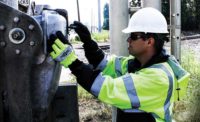Save lives & reduce injury with FR/AR workwear
Burned in a flash

Workplace burn injury and fatalities are frequently the result of the worker’s clothes catching on fire from two primary workplace hazards: flash fire and electric arc flash also referred to as “thermal incidents.”
When a thermal incident ignites non-flame resistant clothing, the worker is exposed to injury from the burning or the melting of the garment. If a garment continues to burn, the area of injury increases and can also result in internal injuries, such as lung and airway damage.
The American Burn Association (ABA) reports that over 486,000 people receive medical treatment for burns each year, and survivors with 40 to 60 percent body burn typically stay 54 days in the hospital with an average cost of $780,000.
OSHA says that ten percent to 45 percent of all burns happen at work and that 40 percent of workplace burn fatalities are from fires and explosions. It is estimated that 50 percent of all jobsite electrical injuries are due to arc flash, resulting in 2,000 people visiting burn centers each year for treatment.
Burn injuries are expensive, debilitating, often life-threatening and in too many cases deadly. Arc-Rated (AR) and Fire-Resistant (FR) clothing can help reduce the risk of burn injury from thermal incidents and is required in many industries, including oil and gas, electric power utilities, metallurgy, mining, paper and pulp, food processing, paint, and for all workers who come in contact with energized electrical equipment.
What is a flash fire?
The National Fire Protection Association (NFPA) defines a flash fire as “a type of short duration fire that spreads by means of a flame front rapidly through a diffuse fuel, such as dust, gas, or the vapor of an ignitable liquid, without the production of damaging pressure.”
Combustible dust is also a flash fire hazard. If it is ignited within a confined space, it can explode and is a potential threat within industries where sanding, polishing or grinding occur.
Although a flash fire is only three seconds or less, it can produce temperatures from 1000 degrees F to 1900 degrees F. Don’t let the three seconds fool you. If a worker is not wearing flame-resistant clothing (FRC), his or her clothing can ignite during that three seconds and continue to burn even though the thermal incident may be over. It is ironic that most burn injuries result from the clothing igniting or melting instead of the incident itself, which is short-lived.
Know this standard
The NFPA 2112 standard is the national consensus “Standard on Flame-Resistant Clothing for Protection of Industrial Personnel against Short-Duration Thermal Exposures from Fire.”
PPE that is compliant with this standard, such as garments, shrouds, gloves, and balaclavas, resist ignition and reduce the severity of burn injuries. This standard specifies test methods, certification standards, minimum design and performance requirements, and labeling instructions.
FR fabrics fall into two categories: treated or inherent. Treated FR fabrics are fabrics in which flame-retardant chemicals are added after the fabric has been woven or knitted. An FR fabric that is considered inherent is made of fibers that are flame-resistant due to the chemical structure of the fibers.
What is an electric arc flash?
The electrical industry is not a stranger to arc flash hazards as many of daily activities expose workers to risk. Some of these risks include voltage testing, removing circuit breakers, and opening bolted panel covers. The NFPA describes an arc flash as “an electric current that passes through air when insulation or isolation between electrified conductors is no longer sufficient to withstand the applied voltage.”
NFPA 70E standard is the national consensus standard for electrical safety in the workplace. Originally developed at OSHA's request, NFPA 70E helps companies and employees avoid workplace injuries and fatalities due to shock, electrocution, arc flash, and arc blast, and assists in complying with OSHA 1910 Subpart S and OSHA 1926 Subpart K.
FR versus AR
According to the current NFPA 70E standard, all arc-rated clothing must also be flame-resistant to qualify for the arc rating. In other words, all AR clothing is FR, but not all FR clothing is AR.
Like FR clothing, all AR clothing must provide both a thermal barrier that insulates workers against burns and the fabric must be self-extinguishing. However, AR garments are required to carry an arc rating on the garment label.
All fabrics specified for use in AR workwear are tested according to ASTM F1959. The arc rating can be reported in one of two ways:
Arc Thermal Protective Value (ATPV), which is a rating of the arc burn protection capability of garment. The higher the arc rating, the more protection a garment gives because the fabric has demonstrated a higher resistance to catching on fire. The ATPV is expressed in calories per centimeter square (cal/cm2) and represents the thermal exposure from an electric arc that will create a second-degree burn in human tissue.
Energy of Breakopen Threshold (EBT) — If the ATPV can’t be calculated because the fabric breaks open, the energy that causes the fabric to break open is called EBT. Like ATPV, the higher the rating, the greater the protection.
Keep in mind that while both values can be reported, only one arc rating is given to fabric and that rating is based on the first value that is reached, which is considered the “lowest value.” According to the ASTM F1506 standard, the lowest value will be used on the garment’s label.
When considering the NFPA 70E standard, approximately 90 percent of all electrical trade workers generally fall into Category 1 and 2, meaning they require arc rated clothing with an ATPV rating of 8 or higher.
The future of FR workwear
FR/AR clothing and the textile industry have seen vast improvements and impressive technological advances in manufacturing, design, and testing in the past 30 years. This trend will continue as new fabrics and fiber blends are created to enhance protection levels, durability, and comfort.
Style and comfort, provided protection is not compromised, is perhaps where the future points -- both are such a critical component of compliance. Designing and developing stylish and comfortable FR Workwear, including FR denim jeans, shirts, and coveralls, will lead to improved employee morale and pride at work.
Looking for a reprint of this article?
From high-res PDFs to custom plaques, order your copy today!





